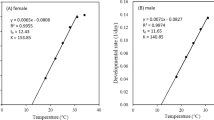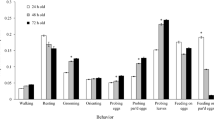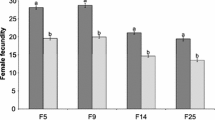Abstract
The influence of the previous parasitization experience and age-related endogenous changes on the parasitization of Sitotroga cerealella Oliv. (Lepidoptera, Gelechiidae) eggs by Trichogramma buesi Voegele (Hymenoptera, Trichogrammatidae) females was estimated in the laboratory conditions. The experiment included two exposures separated by a period lasting from 0 to 20 days at 20°C. The first exposure lasted for 4 h and was conducted at a temperature of 25°C which promoted parasitization. The second exposure lasted 48 h and was conducted at a temperature of 15°C which inhibited parasitization. The survival of the control females (deprived of the hosts at the first exposure) was slightly higher than that of the experimental females. The mean number of mature eggs and the mean fecundity during the second exposure were lower in females that parasitized during the first exposure than in the controls and in females that rejected the host during the first exposure. The proportion of T. buesi females that parasitized S. cerealella eggs during the second exposure was much higher among the females that started parasitization during the first exposure than among controls and among those that rejected the host during the first exposure. This effect of the previous parasitization experience on the following parasitization of the same host species persisted for 16 days. However, on day 20 after the first exposure the proportion of the parasitizing individuals among the experienced females was the same as among the controls and those that rejected the host during the first exposure. This sharp decay in the effect of experience coincided with an increase in mortality and with a decrease in the proportion of parasitizing females among the controls. Thus, the experience-induced behavioral changes per se could be considered as practically permanent, since the period of their persistence is close to the female active life span.
Similar content being viewed by others
References
Babendreier, D., Kuske, S., and Bigler, F., “Non-Target Host Acceptance and Parasitism by Trichogramma brassicae Bezdenko (Hymenoptera: Trichogrammatidae) in the Laboratory,” Biol. Control. 26(2), 128–138 (2003).
Bai, B. and Smith, S.M., “Effect of Host Availability on Reproduction and Survival of the Parasitoid Wasp Trichogramma minutum,” Ecol. Entomol. 18(4), 279–286 (1993).
Barton Browne, L., “Physiologically Induced Changes in Resource-Oriented Behavior,” Ann. Rev. Ent. 38, 1–25 (1993).
Bennett, D.M., Reynolds, K.T., Thomson, L.J., and Hoffmann, A.A., “Individual Level Trade-offs and Artifacts in the Egg Parasitoid Trichogramma carverae (Hymenoptera: Trichogrammatidae),” Ann. Entomol. Soc. Amer. 95(6), 695–700 (2002).
Bergeijk, K.E., Bigler, F., Kaashoek, N.K., and Pak, G.A., “Changes in Host Acceptance and Host Suitability as an Effect of Rearing Trichogramma maidis on a Factitious Host,” Entomol. Exp. Appl. 52(3), 229–238 (1989).
Bjorksten, T.A. and Hoffmann, A.A., “Effects of Preadult and Adult Experience on Host Acceptance in Choice and Non-choice Tests in Two Strains of Trichogramma,” Entomol. Exp. Appl. 76(1), 49–58 (1995).
Bjorksten, T.A. and Hoffmann, A.A., “Persistence of Experience Effects in the Parasitoid Trichogramma nr. brassicae,” Ecol. Entomol. 23(2), 110–117 (1998a).
Bjorksten, T.A. and Hoffmann, A.A., “Separating the Effects of Experience, Size, Egg Load, and Genotype on Host Response in Trichogramma (Hymenoptera: Trichogrammatidae),” J. Insect. Behav. 11(1), 129–148 (1998b).
Bleeker, M.A.K., Van Der Zee, B., and Smid, H.M., “Octopamine-like Immunoreactivity in the Brain and Suboesophageal Ganglion of Two Parasitic Wasps, Cotesia glomerata and Cotesia rubecula,” Animal Biol. 56(2), 247–257 (2006).
Bruce, A.Y., Schulthess, F., and Mueke, J., “Factors Affecting the Bionomics of the Eastern African Egg Parasitoid Trichogramma bournieri Pintureau & Babault (Hymenoptera: Trichogrammatidae),” Ann. Soc. Entomol. France 42(3–4), 423–431 (2006).
Cortesero, A.M., Monge, J.P., and Huignard, J., “Influence of Two Successive Learning Processes on the Response of Eupelmus vuilleti Crw. (Hymenoptera: Eupelmidae) to Volatile Stimuli from Hosts and Host Plants,” J. Insect Behav. 8(6), 751–762 (1995).
Ferracini, C., Boivin, G., and Alma, A., “Costs and Benefits of Host Feeding in the Parasitoid Wasp Trichogramma turkestanica,” Entomol. Exp. Appl. 121(3), 229–234 (2006).
Fleury, F. and Bouletreau, M., “Effect of Temporary Host Deprivation on the Reproductive Potential of Trichogramma brassicae,” Entomol. Exp. Appl. 68(3), 203–210 (1993).
Fukushima, J., Kainoh, Y., Honda, H., and Takabayashi, J., “Learning of Host-Infested Plant Volatiles in the Larval Parasitoid Cotesia kariyai,” Entomol. Exp. Appl. 99(3), 341–346 (2001).
Gandolfi, M., Mattiacc, L., and Dorn, S., “Preimaginal Learning Determines Adult Response to Chemical Stimuli in a Parasitic Wasp,” Proc. Roy. Soc. London, Ser. B 270(1533), 2623–2629 (2003).
Garcia, P.V., Wajnberg, E., Olivejra, M.L.M., and Tavares, J., “Is the Parasitization Capacity of Trichogramma cordubensis Influenced by the Age of the Females?” Entomol. Exp. Appl. 98(2), 219–224 (2001).
Heimpel, G.E. and Casas, J., “Parasitoid Foraging and Oviposition Behavior in the Field” in Behavioral Ecology of Insect Parasitoids: from Theoretical Approaches to Field Applications (Blackwell Publishing Ltd, USA, 2008), pp. 51–70.
Hohmann, C.L. and Luck, R.F., “Effect of Host Availability and Egg Load in Trichogramma platneri Nagarkatti (Hymenoptera: Trichogrammatidae) and Its Consequences on Progeny Quality.” Brazil. Arch. Biol. Techn. 47(3), 413–422 (2004).
Honda, J.Y. and Luck, R.F., “Age and Suitability of Amorbia cuneana (Lepidoptera: Tortricidae) and Sabulodes aegrotata(Lepidoptera: Geometridae) Eggs for Trichogramma platneri (Hymenoptera: Trichogrammatidae),” Biol. Contr. 18(1), 79–85 (2000).
Iizuka, T. and Takasu, K., “Olfactory Associative Learning of the Pupal Parasitoid Pimpla luctuosa Smith (Hymenoptera: Ichneumonidae),” J. Insect. Behav. 11(5), 743–760 (1998).
Jervis, M.A., Ellers, J., and Harvey, J.A., “Resource Acquisition, Allocation, and Utilization in Parasitoid Reproductive Strategies,” Ann. Rev. Entomol. 53, 361–385 (2008).
Keasar, T., Ney-Nifle, M., Mangel, M., and Swezey, S., “Early Oviposition Experience Affects Patch Residence Time in a Foraging Parasitoid,” Entomol. Exp. Appl. 98(2), 123–132 (2001).
Kester, K.M. and Barbosa, P., “Post-Emergence Learning in the Insect Parasitoid, Cotesia congregata (Say) (Hymenoptera: Braconidae),” J. Insect Behav. 4(6), 727–742 (1991).
Lewis, W.J., Vet, L.E.M., Tumlinson, J.H., van Lenteren, J.C., and Papaj, D.R., “Variations in Parasitoid Foraging Behavior: Essential Element of a Sound Biological Control Theory,” Environ. Entomol. 19(5), 1183–1193 (1990).
Makee, H., “Effects of Repeated and Delayed Exposure to Codling Moth Eggs on Reproduction of Trichogramma cacoeciae and T. principium (Hymenoptera: Trichogrammatidae) Females,” J. Pest Sci. 78(1), 83–89 (2005).
Mangel, M., “Evolution of Host Selection in Parasitoids: Does the State of the Parasitoid Matter?” Amer. Nat. 133(5), 688–705 (1989).
Mansfield, S. and Mills, N.J., “Host Egg Characteristics, Physiological Host Range, and Parasitism Following Inundative Releases of Trichogramma platneri (Hymenoptera, Trichogrammatidae) in Walnut Orchards,” Environ. Entomol. 31(4), 723–731 (2002).
Mansfield, S. and Mills, N.J., “A Comparison of Methodologies for the Assessment of Host Preference of the Gregarious Egg Parasitoid Trichogramma platneri,” Biol. Contr. 29(3), 332–340 (2004).
McDougall, S.J. and Mills, N.J., “The Influence of Hosts, Temperature and Food Sources on the Longevity of Trichogramma platneri,” Entomol. Exp. Appl. 83(2), 195–203 (1997).
Mills, N.J. and Kuhlmann, U., “The Relationship Between Egg Load and Fecundity among Trichogramma Parasitoids,” Ecol. Entomol. 25(3), 315–324 (2000).
Minkenberg, O.P.J.M., Tatar, M., and Rosenheim, J.A., “Egg Load as a Major Source of Variability in Insect Foraging and Oviposition Behavior,” Oikos 65(1), 134–142 (1992).
Nurindah, Cribb, B.W., and Gordh, G., “Influence of Rearing Hosts on Host Size Acceptance by Trichogramma australicum,” BioControl 44(2), 129–141 (1999a).
Nurindah, Cribb, B.W., and Gordh, G., “Effects of Physiological Condition and Experience on Oviposition Behaviour of Trichogramma australicum Girault (Hymenoptera: Trichogrammatidae) on Eggs of Helicoverpa armigera Hubner (Lepidoptera: Noctuidae),” Austral. J. Entomol. 38(2), 104–114 (1999b).
Nurindah, Cribb, B.W., and Gordh, G., “Experience Acquisition by Trichogramma australicum Girault (Hymenoptera: Trichogrammatidae),” Austral. J. Entomol. 38(2), 115–119 (1999c).
Reznik, S.Ya., “Learning in the Host Specialization of Insects,” Trudy Zool. Inst. RAN 193, 5–72 (1993).
Reznik, S.Ya., “Intraspecific Variations of Host Specificity in Insect Parasitoids (Using Trichogramma as an Example),” Entomol. Obozr. 74(3), 507–515 (1995).
Reznik, S.Ya. and Vaghina, N.P., “Temperature Effects on Induction of Parasitization by Females of Trichogramma principium (Hymenoptera, Trichogrammatidae),” Zool. Zh. 85(1), 48–53 (2006) [Entomol. Rev. 86 (2), 133–138 (2006)].
Reznik, S.Ya. and Vaghina, N.P., “The Effect of Experience on Response of Trichogramma buesi Voeg. and T. principium Sug. et Sor. (Hymenoptera, Trichogrammatidae) Females to Different Ages of Host Eggs,” Entomol. Obozr. 86(1), 3–13 (2007) [Entomol. Rev., 87 (1), 1–10 (2007)].
Reznik, S. Ya., Voinovich, N. D., and Umarova, T. Ya., “Egg Retention in the Presence of a Host in Trichogramma females,” J. Appl. Entomol. 122(9–10), 555–559 (1998).
Reznik, S.Ya, Voinovich, N.D., and Umarova, T.Ya., “Long-term Egg Retention and Parasitization in Trichogramma principium (Hymenoptera, Trichogrammatidae),” J. Appl. Entomol. 125(4), 169–175 (2001a).
Reznik, S.Ya., Voinovich, N.D., and Umarova, T.Ya., “Comparative Behavioral Analysis of Ovipositing Females and Females with Egg Retention in Trichogramma principium Sug. et Sor. (Hymenoptera, Trichogrammatidae),” Entomol. Obozr. 80(3), 545–555 (2001b) [Entomol. Rev. 81 (8), 895–903 (2001b)].
Reznik, S.Ya., Voinovich, N.D., and Vaghina, N.P., “The Effect of Temperature on the Reproduction and Development of Trichogramma buesi (Hymenoptera: Trichogrammatidae),” Europ. J. Entomol. 106(4), 535–544 (2009).
Reznik, S.Ya., Vaghina, N.P., and Voinovich, N.D., “On the Effect of Temperature on the Induction of Host Parasitization by Trichogramma buesi Voegele (Hymenoptera, Trichogrammatidae) Females,” Trudy Zool. Inst. RAN 314(1), 105–117 (2010).
Roitberg, B. and Bernhard, P., “State-Dependent Problems for Parasitoids: Case Studies and Solutions,” in Behavioral Ecology of Insect Parasitoids: from Theoretical Approaches to Field Applications (Blackwell Publishing Ltd, USA, 2008), pp. 337–356.
Rosenheim, J.A. and Rosen, D., “Foraging and Oviposition Decisions in the Parasitoid Aphytis lingnanensis: Distinguishing the Influences of Egg Load and Experience,” J. Anim. Ecol. 60(3), 873–893 (1991).
Schmidt, J.M., “Host Recognition and Acceptance by Trichogramma,” in Biological Control with Egg Parasitoids (CAB International, Wallingford, UK, 1994), pp. 165–199.
Schöller, M. and Hassan, S.A., “Comparative Biology and Life Tables of Trichogramma evanescens and T. cacoeciae with Ephestia elutella as Host at Four Constant Temperatures,” Entomol. Exp. Appl. 98(1), 35–40 (2001).
Schurmann, D., Collatz, J., Hagenbucher, S., Ruther, J., and Steidle, J.L.M., “Olfactory Host Finding, Intermediate Memory and Its Potential Ecological Adaptation in Nasonia vitripennis,” Naturwissenschaften 96(3), 383–391 (2009).
Smid, H.M., Wang, G., Bukovinszky, T., Steidle, J.L.M., Bleeker, M.A.K., van Loon, J.J.A., and Vet, L.E.M. “Species-Specific Acquisition and Consolidation of Long-Term Memory in Parasitic Wasps,” Proc. Roy. Soc. London, Ser. B. 274(1617), 1539–1546 (2007).
Smith, S.M., “Biological Control with Trichogramma: Advances, Successes, and Potential of their Use,” Ann. Rev. Entomol. 41, 375–406 (1996).
Sorokina, A.P., “The Biological and Morphological Substantiation of the Specific Status of Trichogramma telengai sp. n. (Hymenoptera, Trichogrammatidae),” Entomol. Obozr. 66(1), 32–46 (1987).
Udayagiri, S. and Jones, R.L., “Variation in Flight Response of the Specialist Parasitoid Macrocentrus grandii Goidanich to Odours from Food Plants of Its European Corn Borer Host,” Entomol. Exp. Appl. 69(2), 183–193 (1993).
Van Hezewijk, B.H., Bourchier, R.S., and Smith, S.M., “Searching Speed of Trichogramma minutum and Its Potential as a Measure of Parasitoid Quality,” Biol. Contr. 17(2), 139–146 (2000).
Vet, L.E.M., Lewis, W.J., Papaj, D.R., and van Lenteren, J.C., “A Variable-Response Model for Parasitoid Foraging Behavior,” J. Insect Behav. 3(4), 471–490 (1990).
Vinson, S.B., “The General Host Selection Behavior by Parasitoid Hymenoptera and a Comparison of Initial Strategies Utilized by Larvaphagous and Oophagous Species,” Biol. Contr. 11(2), 79–96 (1998).
Wardle, A.R. and Borden, J.H., “Age-Dependent Associative Learning by Exeristes roborator F. (Hymenoptera, Ichneumonidae),” Can. Entomol. 117(5), 605–616 (1985).
Zaslavski, V.A. and Mai Fu Kwi, “Experimental Study of Certain Factors Influencing Trichogramma Westw. (Hymenoptera, Trichogrammatidae) Fecundity,” Entomol. Obozr. 61(4), 724–726 (1982).
Zaslavski, V.A., Zinovjeva, K.B., Umarova, T.Ya., and Reznik, S.Ya., “Interaction of Circadian Rhythm Synchronized by Photoperiod and Thermoperiod with Direct Influence of Light and Temperature in Adults Eclosion Rhythm Determination in Two Species of the Genus Trichogramma (Hymenoptera, Trichogrammatidae),” Entomol. Obozr. 78(1), 3–14 (1999) [Entomol. Rev. 79 (1), 1–10 (1999)].
Author information
Authors and Affiliations
Additional information
Original Russian Text © S.Ya. Reznik, N.P. Vaghina, N.D. Voinovich, 2011, published in Entomologicheskoe Obozrenie, 2011, Vol. 90, No. 1, pp. 3–16.
Rights and permissions
About this article
Cite this article
Reznik, S.Y., Vaghina, N.P. & Voinovich, N.D. Effects of previous experience and age-related changes on host eggs parasitization by Trichogramma buesi Voegele (Hymenoptera, Trichogrammatidae) females. Entmol. Rev. 91, 281–291 (2011). https://doi.org/10.1134/S0013873811030018
Received:
Published:
Issue Date:
DOI: https://doi.org/10.1134/S0013873811030018




